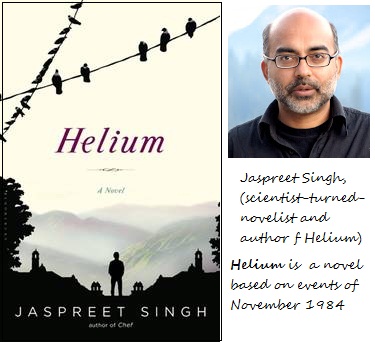(October 27, 2013) Recently an interview by Malini Nair with scientist-turned-writer Jaspreet Singh has been published by Times of India (TOI) over its website. This interview is about Jaspreet Singh’s recent novel ‘Helium’ that is based on the November 1984 massacre of the Sikhs. It is being reproduced below for the information of readers/visitors of the Sikh Siyasat News (SSN).
Not just survivors, nation needs to mourn 1984 riots: Jaspreet Singh
Malini Nair | Oct 27, 2013, 06.44 AM IST | Times of India
Facts, fiction and pure chemistry merge in Canadian research scientist-turned-writer Jaspreet Singh’s novel, ‘Helium’, based on the 1984 anti-Sikh riots. India, Singh tells Malini Nair, hasn’t mourned enough for those who died in the conflagration and not learnt anything from it either.
Why did you feel the need to revisit the 1984 riots at this point?
One does not decide to visit 1984. 1984 keeps visiting us. It is the return of repressed, re-emerging memories triggered by current events. In 2008, after finishing my first novel, I was invited to Delhi to have a series of conversations with HIV positive orphans. The children demanded stories, heartbreakingly enough, ghost stories. Every afternoon after the story telling, I would step out for long walks through the city, and it was then the real ghosts of 1984 started returning — by a photocopier shop in Munirka, a car mechanic’s shop, near the Jawaharlal Nehru University. As I was processing those Delhi experiences, walking with the ghosts, I started writing. Rahul Gandhi recently spoke of putting away his anger at his grandmother’s assassination. What do you say to this “forget and move on” approach for those who survive violent acts?
Raj, the narrator of Helium, faces a huge predicament. His own father, a senior IPS officer, facilitated the violence in November 1984. In the story, under the watchful eyes of the cops a mob directed by senior Congress party leaders had burned to death Raj’s beloved IIT professor. Later a traumatized Raj asks a question which might be of some significance to the younger generations in India: how do sons and daughters deal with the crimes of their fathers? Raj is unable to move forward until he has processed this question. Ultimately, he decides to acknowledge the crime of his father. He no longer hides it, or distorts it, and he is no longer silent about it.
Are there any autobiographical strains in your book?
I was a teenager in Delhi in 1984. I saw ash particles floating in air. Like Raj, the central character of my book, I too studied science and engineering. At the same time, Helium involved a lot of research and relied on survivor and relief worker testimonials. It is based on oral histories and private archives. The hybrid form allowed me to pose questions like: ‘What happened?’ and ‘What could have happened?’ It also allowed me to create distance.
You talk of nearly abandoning the project. Was it difficult extracting these memories?
What we are really talking about here is complicated grief and collective trauma. Unfinished mourning. Not just memory, but also postmemory and transmission of trauma. It is never easy.
Why did you choose to weave the facts you collected into fiction?
For me, Helium is really rough-and-ready notes for a book that belongs to the ambiguous, interstitial zone between history and traumatic memory — between the ‘objective’ and the ‘intimate’. This form allowed me better access to the pogroms of November 1984 and the years that have followed. To try to do it otherwise, as in say a human rights report, is a paralysing affair, and affects our capacity as human beings to engage fully with the crime of crimes.
Why did you bring in the work of Italian scientist and holocaust survivor Primo Levi into the book?
Primo Levi’s The Periodic Table is a fine way for a chemist to organize memories. The book has 21 chapters, each titled after a chemical element. Argon, Hydrogen, Potassium, Sulphur, Tin, Nitrogen, Nickel, Mercury, Gold…He sees strange parallels between humans and the properties of these atoms. Helium is also a homage to another favourite writer of mine: WG Sebald. Both were engaged with the subject of genocidal violence and other calamities.
There is a strong indictment of the Congress establishment in the book. Do you believe that the apology hasn’t worked as a salve?
To this day, senior Congress leaders involved in the pogrom and their loyal protectors enjoy infinite immunity. Non deliverance of justice often creates uncomfortable situations like this one in the book: the Sikh victim’s wife Nelly is retiring as a chief librarian and the chief guest for the occasion is a cabinet minister who had incited the mobs. November 1984 requires an enormous ‘work of mourning’, not just by the survivors and the targeted collective, but by the entire nation.
You refer to the emerging saffron brigade in the book. Do you feel a sense of unease at this?
A recent article on the net called it the ‘Sophie’s choice’ for India’s electorate. My narrator’s consciousness is saturated with similar anxieties. For him mass murder is mass murder — whether organized by the ‘right wing’ or the ‘liberals’ or the ‘left wing’. A pogrom is a wound on the psyche of the collective and if left untouched it may result in repetitions that are similarly ignored.
***
Note: (1) As SSN has reproduced above content from an outside source, we have not changed or edited it.
(2) Sikh Siyasat News (SSN) is of the view that it’s improper to term the events of November 1984 as “riots” because these were planned and organized genocidal massacres. But Indian media prefers to use the term “anti-Sikh riots” for these events, as is evident from the use of term in above write-up.
(3) Above write-up/interview may be accessed on its source page at: http://timesofindia.indiatimes.com/home/stoi/all-that-matters/Not-just-survivors-nation-needs-to-mourn-1984-riots-Jaspreet-Singh/articleshow/24772091.cms .

